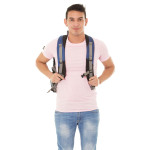 According to the American Occupational Therapy Association, Inc. (AOTA), 85% of university students report discomfort and pain associated with backpack usage. However, studies have also shown that simply changing the way you load and carry your backpack will lower your chance of straining your shoulders, back, or neck.
According to the American Occupational Therapy Association, Inc. (AOTA), 85% of university students report discomfort and pain associated with backpack usage. However, studies have also shown that simply changing the way you load and carry your backpack will lower your chance of straining your shoulders, back, or neck.
What’s the best way to carry my books?
Although there are many types of school bags, a backpack over both shoulders is the best way to carry books because it helps distribute the weight evenly.
How do I know if my backpack is too heavy?
As a rule, students tend to put too many books, notebooks, and other items in their backpacks, which make them very heavy to carry. According to the American Occupational Therapy Association Inc., backpacks should not weigh more than 10% of your weight. For example, if you weigh 100 pounds, your backpack should not weigh more than 10 pounds. If you absolutely need to carry all of your books with you, carry one of the heavier ones in your hands.
What can happen if I carry a backpack that’s too heavy?
Carrying a heavy backpack has consequences. When backpacks are too heavy they can cause you to stand in an awkward position. This affects your posture, and over time, causes pain. Tight straps can actually cause tingling and/or weakness in your arms and hands if a nerve is pinched. If you have any tingling or weaknesses, make an appointment with your health care provider.
How can I pack a lighter backpack?
There are many ways to pack a lighter backpack. Start by taking out everything that can be left either at home or in your locker. If your teachers ask you to keep binders, a good idea might be to leave the binders in your locker and just carry the loose leaf sheets in a folder instead. At the end of the day, you can reinsert the sheets of paper into your binders.
Is there a right way to wear a backpack?
Yes, there is a right way to wear a backpack. Wearing a backpack correctly is important. Don’t use one strap over one shoulder to carry your backpack. Be sure to use both shoulder straps and adjust them so they are even. The waist belt also helps to keep the contents of your backpack evenly distributed, which in turn helps prevent pain.
Choosing a backpack
- Pick a backpack with a well-padded back so that sharp objects inside the bag won’t poke you
- Choose a backpack with a waist belt
- Choose a backpack with well-padded shoulder straps
- Choose the right size backpack- don’t choose a back pack that is too small
- Remember, the bottom of your bag should rest at the top of your lower back
- Select a backpack that’s made out of a light material
- Look for a backpack with multiple compartments – it distributes the weight more evenly
- If you must carry a heavy load, consider buying a backpack that rolls on wheels
Packing your backpack
- Place the heaviest books closest to your back
- Carry only what you absolutely need and no more
- Arrange your books, papers, pencils and other items so they won’t slide around
Picking up your backpack
- Bend your knees and lift your pack using both hands
Wearing your backpack
- Use both straps rather than slinging the pack over one shoulder
- Adjust the straps so they are secure and they feel comfortable
- Use the waist belt if your pack has one
Source: Read Full Article





